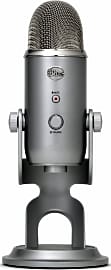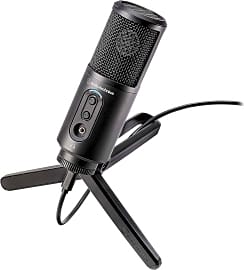The 10 Best USB Microphones

This wiki has been updated 40 times since it was first published in May of 2015. Podcasters, amateur musicians, and anyone looking to capture high-fidelity recordings at a reasonable price without the hassle of a complicated audio interface will find the perfect solution in our selection of capable USB microphones, some of which outperform many mid-grade studio models. We've ranked them here by sound quality, versatility, durability, and ease of use. When users buy our independently chosen editorial recommendations, we may earn commissions to help fund the Wiki.
Editor's Notes
July 28, 2020:
While Neewer does a pretty good job creating products that function well outside of their price ranges — especially in the camera equipment sector — their USB mic just wasn't good enough to stay on the list, certainly not when the JLab Audio Talk Pro is out there. The JLab might not have the most durable build (neither did the Neewer), but its sound quality is outstanding for the cost, with a 24-bit/192kHz sample in its analog to digital conversion.
It's important for anyone to keep an eye out for features that will help them with their specific needs. The multiple polar patterns of the Blue Yeti Silver are really useful if you're recording a solo podcast one day, then a conversation the next, and an instrument after that. But if all you need is a mic to track vocals over some music, it'd be better to focus on a model with less versatility and more pure sound quality, like the Audio-Technica ATR2500X.
Some of these models are going to come with useful accessories, as well, like desktop stands, pop filters, cables, and more. A few even have pop filters built-in, but one of the great things about an external filter (like the one that comes with the Apogee Hype Mic) is that you can set it a certain distance from the mic to ensure you don't come too close to it and pass by its sweet spot.
May 31, 2019:
On this update, we bumped the Blue Yeti Silver up from #5 to #2. In making this decision, we considered all the factors that set it above many of its competitors, including its fantastic sensitivity, practical simplicity, and the versatility provided by its multiple pattern selection. Worth mentioning, too, is its long-standing reputation in the broadcasting community.
We made the decision to cut the Blue Spark Lightning from our list, and in its place, we added the HyperX Quadcast at #6. We felt our options were a bit lacking for those in the market for a USB mic oriented towards gaming and live-streaming, especially thanks to its unique tap-to-mute function. Though the Blue Spark Lightning was one of the better models on the market in the years immediately following its release, we now deem it as one of the company's weakest units, and feel that it doesn't stand up to the robust competition it currently faces.
Special Honors
Lewitt Audio DGT-650 This selection boasts a number of useful features, like a level meter facing the performer and a dedicated box for cable management that includes a MIDI port. It comes with a rugged shock mount and a software suite for Windows that can help you get the most out of the mic. That said, it is a little pricey for a model the conversion in which caps out at 96kHz. lewitt-audio.com
Under Pressure
In either case any power needed by either the microphone or the pre-amp comes to both through the USB cable itself.
You can accomplish a lot with just a little pressure. Squeeze a crystal like quartz, for example, and it'll produce a steady electrical charge out either end. Noise vibration is a kind of pressure exerted through the air in the form of sound waves. That's what causes a rolled up piece of paper to project your voice further than it could go on its own. You pressurize the paper with your voice and that vibration travels outward into the air.
Microphones work not by amplifying sound the way our paper megaphone above would, but more like a human translator would interpret a speaker from one language to another. Words come in through one opening, translate into electrical impulses, and reemerge anew. In the case of the microphone, they are amplified and recorded, where the translator simply speaks them in a new tongue.
When you sing or speak into a microphone, a small diaphragm usually made out of plastic vibrates in direct proportion to the pressure your sound waves put on it. That vibration transfers to a metal coil that's both attached to the diaphragm and also wrapped around a magnet. That magnetic interference produces a signal in the wire attached to its other end and sends that signal down the length of microphone cable to a given output device.
Some of the microphones on this list are condenser microphones, which means that their diaphragms vibrate a capacitor before using the magnet beyond to translate the vocal pressure into an electrical signal.
What makes these USB microphones unique is that they interact with your computer's sound card, sending the signal either directly via USB cable or through an intermediary XLR cable to a small pre-amp before reaching your computer. In either case any power needed by either the microphone or the pre-amp comes to both through the USB cable itself.
To Each His Or Her Own Sound
It may be tempting to despair over the idea that you couldn't really evaluate the quality of any of these microphones without hearing them. After all, different voices are going to get different responses from the same microphone. Thom Yorke from Radiohead, for example, uses an insanely expensive large-diaphragm condenser microphone because its stabilization of certain frequencies in the upper register helps his naturally nasal voice sound more palatable to the average listener.
None of these mics is really built for tracking heavy electric guitar or drum sounds without running into a little natural distortion of their own.
Now, if you aren't up for spending big money on your microphone (and additional hardware to wire into your computer via USB), you still have tremendous options laid out before you, and you don't need to worry too much about how each will treat your voice.
The real concern should be what your intended use is for each microphone. As much as sound plays a role in this particular point, you'll also want to consider ergonomics. Take the Snowflake and the Snowball by Blue, for example. Each will produce lovely tones for speech if you want to run a good podcast or do voice-over work from home, but neither makes for an effective interview mic in the field. Their shape is all wrong for the handling you'd need.
The more expensive microphones on this list are the ones that resemble traditional studio vocal mics, and they're stellar for tracking your band's vocal melodies as well as picking up acoustic guitar sounds and some lighter percussion. None of these mics is really built for tracking heavy electric guitar or drum sounds without running into a little natural distortion of their own. But if the Kinks were willing to slice up their amps with razor blades to get their signature sound, maybe pushing a USB mic to its limit will get you something special.
Take a close look at connectivity, as well. Not all of the microphones on our list have completely removable USB cords. One or two are hard-wired, so when–and I mean when–that cord wears down, your otherwise perfectly good microphone becomes useless.
Persona Non Grata
Reaching incredibly far back into the heyday of the Greek theatre, actors often wore masks as part of their performances. The masks served a dual purpose. They helped audience members identify and discriminate between and among characters, and they also helped project the sound of the actors' voices throughout the amphitheater.
These were the very first known devices for amplifying the human voice.
The masks were called personae, a combination of Latin roots for through (per) and sound (son). Literally, the thing through which the sound travels. These were the very first known devices for amplifying the human voice.
Nearly 2,500 years later, the microphone made its debut. Invented by combining the efforts of inventors John Philipp Reis and Alexander Graham Bell, the late 19th century saw the very first transmission of the human voice into a usable electrical current that could be transmitted and amplified at will.
Over 100 years later, a consortium of computer manufacturers collaborated to reduce the variety and complexity of the inputs and outputs plaguing computer hardware design in the 1990s. The result was the introduction of the USB format in 1996. In the intervening 20 years, the format remains the standard despite several attempts to surpass its speed and convenience, and that speed has only increased from a maximum 12 megabits per second to today's impressive 7.2 gigabits per second.
Given the speed, reliability, and ubiquity of USB in modern computing, it serves as the perfect intermediary for electronic audio signals.















